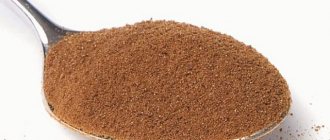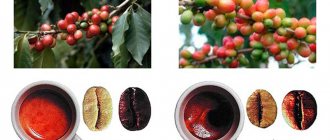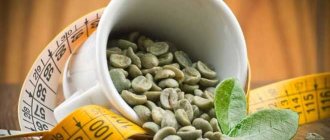There are many options for coffee - there is instant, there is ground, there is bean. Many can unwittingly get confused in this diversity. At the same time, there are also questions about the benefits of various versions of this drink - what is better for the body: strong ground or easier instant.
Article on the topic Sleepless night.
What happens if you don't let yourself sleep with the help of coffee? Humanity's love for coffee goes back many years - its fruits were known back in 850. But only a few centuries later he won unconditional adoration in the world and crazy popularity. In Russia, coffee was often used as a cure for a number of diseases. Active consumption of the drink began in the 18th century - it was then that the innovator Peter I introduced the culture of coffee consumption at court.
Coffee beans contain many useful substances - you can find potassium, manganese, vitamin B5 and B2 in it; its calorie content is not so high - only about 2 kcal per 100 ml. But at the same time, debates about the benefits and harms of this strong “energy drink” do not subside everywhere.
According to the results of a number of studies, coffee helps reduce the risk of developing diabetes, prevents cardiovascular diseases, can prevent the development of Parkinson's disease, and reduces the risk of cancer. But at the same time, it can be quite dangerous. For example, it causes premature birth in pregnant women and causes exacerbations of certain diseases. Of course, it is important not to forget about the norm - in terms of pure caffeine, 10 g of the substance is fraught with death.
Doctors recommend drinking no more than 1-2 cups of coffee drink per day. At the same time, there is also advice that it should be supplemented with water to avoid dehydration, since coffee has a certain diuretic effect. But which option can make a person’s health worse? What to choose - ground, instant or another type of coffee, AiF.ru was told by the head of the outpatient department of the Medincenter hospital (a branch of GlavUpDK under the Ministry of Foreign Affairs of Russia), an endocrinologist of the highest category, Ph.D. Elena Mamontova .
Soluble or natural?
Both instant and ground natural coffee are extremely common throughout the world and are in great demand. However, they have significant differences.
Soluble
Instant coffee is a drink made from coffee beans that have been processed to turn them into powder or granules that are soluble in water. The first stage of production is roasting the beans and subsequent grinding. The mixture is then poured with hot water and dried in various ways, which determine the type of instant coffee:
- Sublimated. The crushed grains are frozen and dehydrated in a vacuum environment. Freeze-dried coffee is distinguished by the preservation of almost all nutrients and high cost.
- Powder. The mixture is sprayed into a stream of hot air, then quickly dries and turns into powder. This option is the cheapest on the market and has a weak taste and aroma.
- Granulated. Made from coffee powder. The powder is moistened in water, then pressed until granules appear.
The main advantages of instant coffee are low cost and long shelf life.
Negative aspects - less pleasant (rich) taste and aroma, low caffeine content (2-3 times less than in a natural product).
But the main disadvantage of instant coffee is the high content of a toxic substance - acrylamide (about 2 times higher than in natural coffee). This substance can provoke the growth of malignant tumors (ovaries, endometrium), depress mental work, reduce fertility and increase the likelihood of early development of type II diabetes mellitus. American scientists came to these conclusions.
Natural
Natural coffee is a drink made from ground whole coffee beans. There are over 90 plant species growing in the world that belong to the genus Coffea, but only a few varieties are produced on an industrial scale:
- Arabica. The most common option (up to 90% in the world). The grains have an oblong shape and a smooth surface. During the roasting process, many unburnt areas remain due to the presence of an S-shaped groove.
- Robusta. It is characterized by a high caffeine content and a less pleasant aroma compared to other varieties. The share of world coffee is 5-7%. It is usually used not in pure form, but as mixtures, which makes the final drink cheaper. The grains have a round shape, without features.
The key stage in the production of natural coffee is roasting the beans. It is during this procedure that the beans acquire their characteristic brown color, the severity of which is determined by the degree of roasting. There are 4 degrees of roasting:
- light (Scandinavian);
- medium (Viennese);
- dark (French);
- very dark (Italian).
With a high degree of roasting, coffee beans lose valuable nutrients and also accumulate compounds that are toxic to the body, for example, acrylamide. However, the higher the degree of roasting, the brighter the taste and aroma. You should not overuse very dark varieties of coffee.
Scientists say that it is natural, freshly ground light and medium roast coffee that is most preferable for humans. See 14 beneficial properties of natural coffee here →
Comparison table
To understand which drink is healthier for a particular person, you should pay attention to the main differences between instant and ground (bean) coffee. They are presented in the table:
| Criterion | Soluble | Natural |
| Antioxidant content | Average | High |
| Taste and aroma | Less pronounced | More pronounced (proportional to the degree of roasting) |
| Caffeine concentration per 1 cup (170 ml) | 60-90 mg | 80-140 mg |
| Acrylamide concentration | 358 mcg/kg | 150-170 mcg/kg |
| Calories per 1 cup | 4 calories | 2 calories |
| Content of macro- and microelements per 1 cup (170 ml) | ||
| Calcium | 7.2 mg | 3.6 mg |
| Omega-6 fatty acids | 3.6 mg | 1.8 mg |
| Magnesium | 7.2 mg | 5.3 mg |
| Phosphorus | 5.4 mg | 5.3 mg |
| Potassium | 53.7 mg | 87.2 mg |
| Sodium | 7.2 mg | 3.6 mg |
| Caffeine | 46.5 mg | 71.2 mg |
Thus, it is recommended to give preference to natural coffee varieties that contain natural, technologically unaltered nutrients. It is important to note that natural coffee beans have a more pleasant taste and aroma, contain fewer toxic substances and have lower calorie content. Of all roast types, you should choose a low or medium level.
Caffeine in ground and instant coffee
Natural coffee can be made from Arabica or Robusta beans. Arabica has less caffeine, Robusta has more (but lacks many useful substances). Instant is all made from robusta, and one would assume that it would have more caffeine. But this is not true: during digestion, only about 50% of the caffeine is separated from the beans, so in any case, there will be less of it in the soluble version.
On average, a cup of coffee made from a spoonful of ground beans contains 95 mg of caffeine, and a cup of instant coffee (1 spoon) contains 27 mg. The numbers are approximate, since much varies depending on the specific brand and cooking method, but they give an idea of the approximate ratio. If you need to cheer up, you should definitely give preference to natural ones.
Sometimes there are arguments that instant coffee has less calories. Only 2-3 calories per cup. At the same time, ground has 5-6 calories. There is a difference, but it is insignificant for the body, and it is impossible to gain weight from a natural drink.
Which cooking method is best?
As we have already found out above, natural coffee beans are the most preferable option. However, there are different methods of preparing the drink, which have their own disadvantages and advantages.
The following cooking methods are distinguished:
- "Turkish way" (in Turk). Turk is a utensil for making coffee. Usually, for this option, the finest grinding of grains is used, from which the taste and aroma have time to partially “come out.”
- French press. It is a device in the form of a cylinder with a piston-filter. Ground coffee is poured into a flask, filled with hot water (about 70-90 degrees) and infused for 5 minutes. Then the piston is lowered and the drink is poured into glasses.
- Filter coffee. It is done using various filters (most often paper). Ground coffee is poured into the filter and filled with hot water. The drink seeps through the pores and pours into cups.
- Geyser coffee maker. In the device, coffee is poured into one of the compartments, water is poured into the other, and it is installed on any heating surface (for example, on a gas stove). Steam under pressure passes through the compartment with ground coffee and is collected in the next container (with the finished drink).
- In a thermos. The principle is simple: ground grains are poured into a thermos, filled with hot water and left in this state for 1-3 hours.
- In the coffee machine. This device automates the coffee preparation process. Either ground or whole beans are loaded into the coffee machine (in this case, grinding occurs in the machine itself). The principle of operation is to pass hot water through a layer of ground coffee under pressure. Modern coffee machines have many additional built-in functions (milk frothing, etc.)
The most useful option for brewed coffee is “Turkish” (in Turk). During the preparation process, the drink retains the maximum amount of antioxidant substances and macroelements. The only drawback of boiled coffee is its less pleasant taste and aroma. It is important to consume the drink within the first 5-15 minutes from the moment it is ready, otherwise the totality of positive qualities will gradually be lost. Yesterday's coffee has a minimum of nutrients.
Exposure to a water temperature of less than 95 degrees (geyser coffee maker, French press) does not allow valuable components to escape from ground beans and is less useful.
Coffee from a thermos is the most undesirable option due to the long standing time.
There are many options for preparing an invigorating drink, the most useful of which is the “Turkish” method of preparation using Turks. It releases the maximum amount of nutrients from grains.
What kind of coffee is better to drink?
It is highly undesirable to consume cheap, low-quality fast food products. You should choose between natural ground and instant freeze-dried. The main evaluation criteria are compliance of organoleptic indicators with personal preferences, the presence of chronic diseases and the quality of coffee.
It is advisable to give preference to natural ground drink, since the drink has a beneficial effect on the human body when consumed in moderation, is healthier in composition, does not contain chemical additives, and invigorates in the morning. Instant is suitable if you don’t have enough time to cook in a Turk and you can’t consume caffeine. In the latter case, we mean products that almost do not contain this alkaloid and have the corresponding designation on the packaging.
Which coffee drink is healthier?
Many drinks are made based on coffee, the most popular of which are:
- "Espresso". It is prepared (usually in a coffee maker) exclusively from beans with the maximum degree of roasting. It has a low calorie content (7 calories). Served in 30-35 ml cups, it contains approximately 63 mg of caffeine. There are several classic variations: “lango” - diluted with water up to 55 ml, “Americano” - up to 150-160 ml, and “doppio” - double “expresso” (contains approximately 125 mg of caffeine).
- "Cappuccino". It is also produced on an espresso basis. Whipped milk is added to the drink (70-80% of the drink consists of milk). The caffeine content is similar to espresso. All ingredients are served warm in a cup with a volume of 150-190 ml. Energy value – 105 calories per 150 ml glass.
- Macchiato is a mixture of espresso and milk foam in a 1:1 ratio. Volume – 60-70 ml. Nutritional value: 66 calories.
- "Latte" . It is a milk drink. 75% is represented by milk. Served in transparent vessels with a volume of about 200 ml. Energy value – 112 calories.
- Moccacino is a coffee drink with the addition of chocolate, cocoa powder or chocolate syrup. Served in glasses with a volume of 200-250 ml. Contains about 270-320 calories.
Considering the characteristics of each drink, we can conclude that the most useful are “espresso” in its pure form and cappuccino. They are distinguished by sufficient caffeine content and low calorie content.
Which brand to choose
Almost every year, various culinary publications, retail chains or regulatory organizations compile ratings of the best coffee brands. In my opinion, this exercise is pointless, since “taste and color”, as you know... And the opinion of any of these sources is to a certain extent subjective. Therefore, only you can make your own rating of the best coffee samples for your taste. Based on your experience and taste preferences.
To navigate the abundance of brands represented on the domestic market, you can rely on sales statistics:
- For coffee machines, the brands most often purchased are Julius Meinl, Gaggia, Saeco;
- in grains choose Lavazza, Paulig and Jardin;
- popular instant brands - Egoiste, Carte Noire, Nescafe;
- ground – Living Coffee, Illy, Kimbo.
Which supplements are best?
Traditionally, additional ingredients are added to coffee to give it a more refined taste and aroma, which allows you to enjoy the drink to the fullest. But not all supplements are created equal.
Below are the most popular supplement options and their effect on the body:
- Milk. Softens the bitterness of the drink, enriches it with additional antioxidants. Milk also helps maintain the integrity of the musculoskeletal system and prevent fractures, additionally reduces the risk of malignant neoplasms (colon and rectal cancer), reduces the likelihood of early cardiovascular mortality, and prevents the development of type II diabetes.
- Cream. Cream is the thick, fatty top layer of milk. They improve the taste, but significantly increase the energy value of the drink.
- Sugar. Allows you to reduce the bitterness of the invigorating drink. Belongs to the group of quickly digestible carbohydrates, which are extremely harmful to the heart and the entire body.
- Honey. For a long time it was believed that honey is an excellent alternative to “harmful” sugar, but recent scientific research completely refutes this information. It disrupts metabolism and increases the risk of heart attack and stroke due to its negative impact on the lipid profile.
- Lemon. Adds a special sour taste to the drink. Helps normalize the lipid profile (reduces total cholesterol and the concentration of low-density lipoproteins), prevents the development of cardiovascular diseases and their complications, and is especially effective in lowering blood pressure.
- Turmeric. Scientific research demonstrates that turmeric is beneficial for blood vessels and the heart, provides reliable prevention of atherosclerosis, type II diabetes, and improves the rheological properties of blood.
- Cinnamon. This spice inhibits the activity of pathogenic bacteria in the body, reduces the severity of inflammatory processes in the digestive tract, increases the sensitivity of peripheral tissues to insulin, reduces blood pressure (mainly the systolic component) and strengthens the immune system in general.
- Cardamom. It has general tonic properties and enhances the “invigorating” effect. Helps strengthen local and general immunity factors, slightly inhibits the effects of caffeine (recommended for strong coffee varieties).
- Carnation. The main advantages are a bright rich taste, lowering blood pressure and reducing blood viscosity. Recommended for people with pathologies of the blood coagulation system.
- Ginger. It increases the amount of lipoproteins with a high specific gravity, and reduces those with a low specific gravity, resulting in the prevention of atherosclerosis. Helps increase the activity of metabolic processes (useful for weight loss).
Coffee additives have different effects on the body. It is recommended to avoid adding honey or sugar. It is better to add lemon, turmeric, cinnamon, cardamom and ginger.
How to choose ground coffee
Many people prefer to buy natural coffee already ground. This saves time and eliminates the need to think about additional equipment such as a coffee grinder or coffee machine. Each grind level has its own purpose:
- coarse grinding is suitable for piston coffee makers; such a drink will have to be infused for at least 10 minutes;
- medium – suitable for geyser and filter coffee makers and is generally quite universal;
- thin – used for espresso coffee machines and also for filter coffee makers;
- ultra-fine - grinding, similar to flour, is produced specifically for Turks.
In my opinion, ground coffee has two disadvantages. Firstly, after opening the package, it quickly loses its aroma and taste. Secondly, some manufacturers sin by adding flavorings to it, and not always natural ones. Therefore, if you have opted for ground coffee, buy packages of the minimum volume. And carefully read the label information about additives.
Special varieties
- Bulletproof coffee is a high-calorie product based on regular coffee, unsalted organic butter and MCT oils. Promotes weight loss by putting the body into “ketosis” mode and prolongs life in general.
- Decaffeinated coffee or “decaf” is a product from which almost all caffeine (up to 97%) is technologically removed. As a result, there is no effect of this biologically active substance, the list of contraindications for coffee is narrowed (acute inflammatory lesions of the digestive system, refractory arterial hypertension, etc.).
- Cold or iced coffee is a serving option in which the coffee drink is consumed cool, usually in the summer to quench thirst and improve performance. There are 2 main cooking options: diluting with cold milk or cooling.
There are “non-standard” options for drinks based on coffee beans, which are used for a highly specialized purpose. Their difference from “template” forms makes them unique, but they are not suitable for everyone.
Is coffee good or bad for your health?
As soon as coffee began to be imported to Europe from the Arab states, controversy arose about whether this drink was good for health. They continue to this day. Nowadays, coffee has become an everyday drink for many people, the consumption of which allows them to feel alert throughout the day. This stimulating, tonic drink is drunk by people of different ages. Some of them limit themselves to one cup at breakfast, others drink coffee several times a day. For some people, drinking this drink has become a real addiction. It should not be abused, especially for those people who have diseases such as atherosclerosis, hypertension, insomnia, coronary heart disease, gastritis, etc.
What kind of coffee is healthy to drink? Which coffee is healthier - ground or instant? Many people are interested in the answers to these questions. Let's try to understand this situation and answer the above questions.
A few words about the history of coffee
The first documented study of this issue was the “coffee experiment”, which was carried out in the seventeenth century by the Swedish king Gustav III. Convinced of the dangers of this product, he decided to prove he was right with the help of a scientific experiment. Two twins sentenced to death had their sentences commuted to life imprisonment. In return, they had to drink three cups throughout their lives - one twin of tea and the other of coffee. Gustav failed to prove that coffee is harmful. The twin who drank tea was the first to die, and at a very respectable age - at 83 years old. The brother who constantly drank coffee was able to survive it. The king himself died much earlier, without waiting for the end of the experiment.
Instant coffee powder was first released in 1934. The technologies for its preparation have improved significantly since then, but even today the most healthy and tasty is considered a natural product prepared from ground grains. The coffee content in it is one hundred percent. In a soluble product, this figure is only fifteen percent, and the rest is additives. Chemical stabilizers and preservatives contained in freeze-dried or powdered drinks can cause gastritis and other stomach diseases. Drinking a natural grain drink does not have a negative effect on the gastrointestinal tract.









